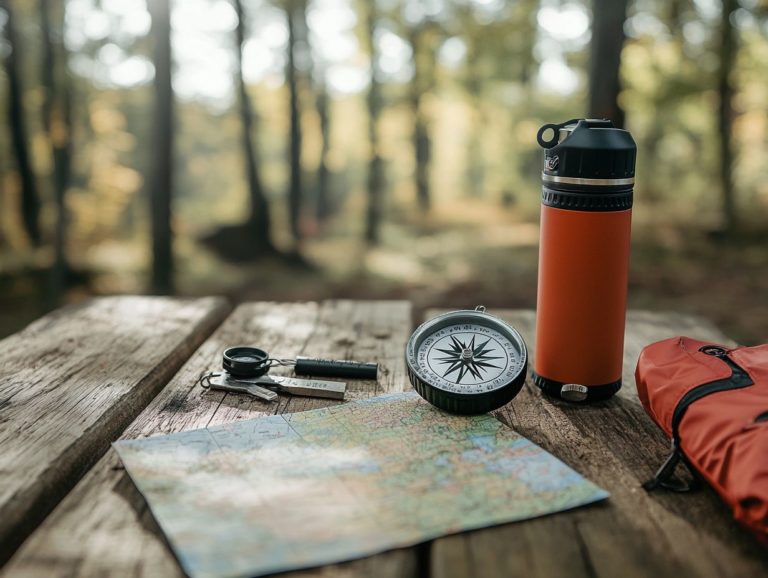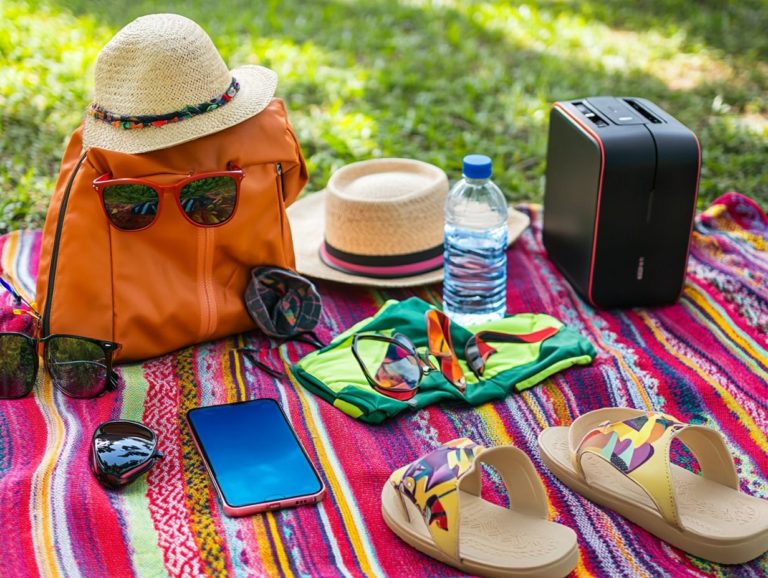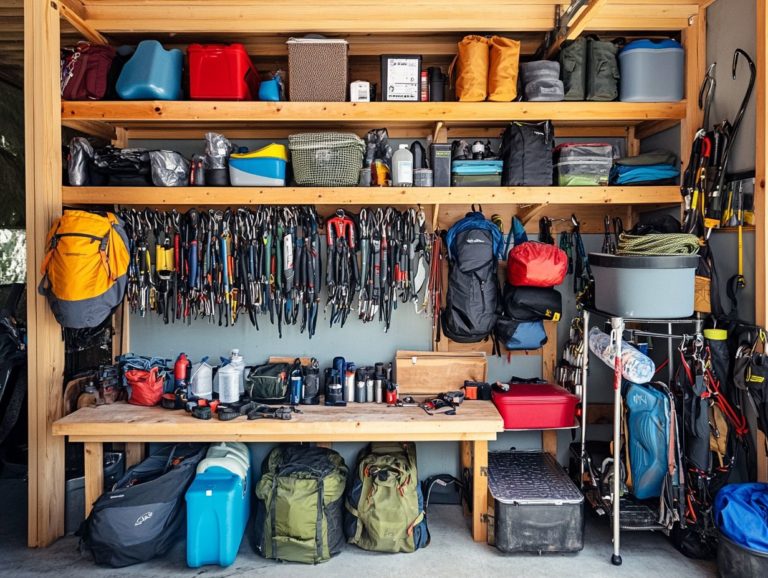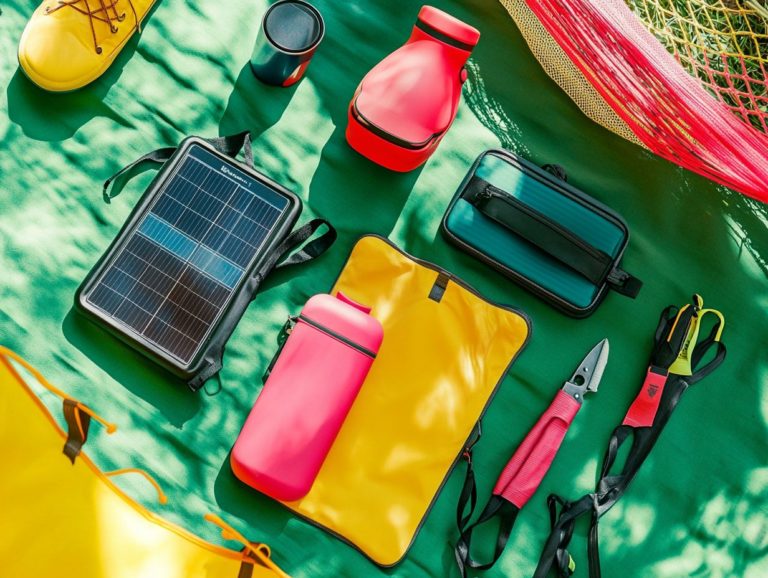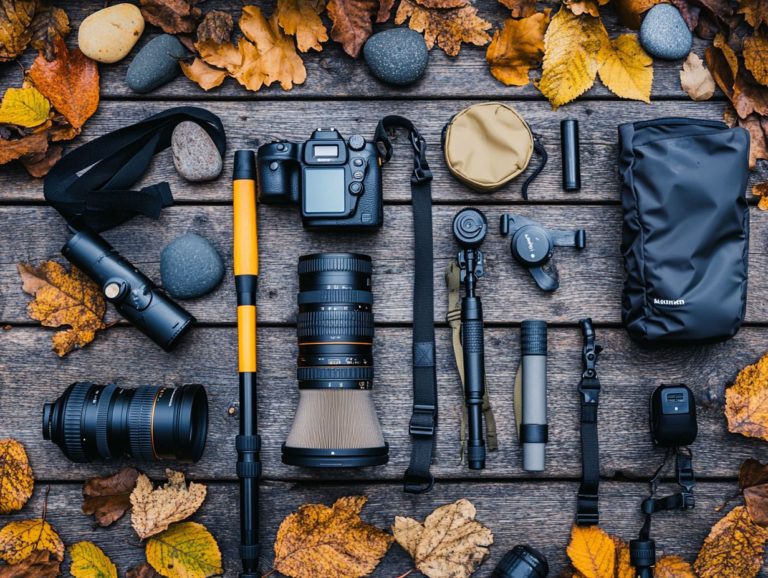Essential Accessories for a Safe Hiking Trip
Hiking offers a remarkable opportunity to connect with nature, but preparation is paramount for ensuring both hiking safety and enjoyment during your adventure.
Whether you’re a seasoned trekker or just starting out, having the right gear can truly transform your experience. From the perfect hiking shoes to essential hiking tools for navigation, there are hiking accessories you simply cannot afford to overlook.
You will explore common hiking injuries, effective prevention strategies, packing best practices, and tips for dealing with unexpected weather.
Get ready to hit the trails with confidence and excitement!
Contents
- Key Takeaways:
- 1. Proper Hiking Shoes
- 2. Navigation Tools
- 3. First Aid Kit
- 4. Sun Protection
- 5. Appropriate Clothing
- 6. Hydration Pack or Water Bottle
- 7. Emergency Shelter
- 8. Headlamp or Flashlight
- 9. Multi-Tool or Knife
- 10. Whistle
- 11. Insect Repellent
- 12. Map and Compass
- 13. Emergency Communication Device
- 14. Snacks and Food
- 15. Personal Identification and Emergency Contact Information
- What Are the Most Common Injuries While Hiking and How Can They Be Prevented?
- Frequently Asked Questions
- What are the essential accessories for a safe hiking trip?
- Why is it important to have a map and compass for a hiking trip?
- What should be included in a first aid kit for a hiking trip?
- Why is proper footwear necessary for a hiking trip?
- What type of clothing should I pack for a safe hiking trip?
- Why is it important to have a headlamp or flashlight for a hiking trip?
Key Takeaways:
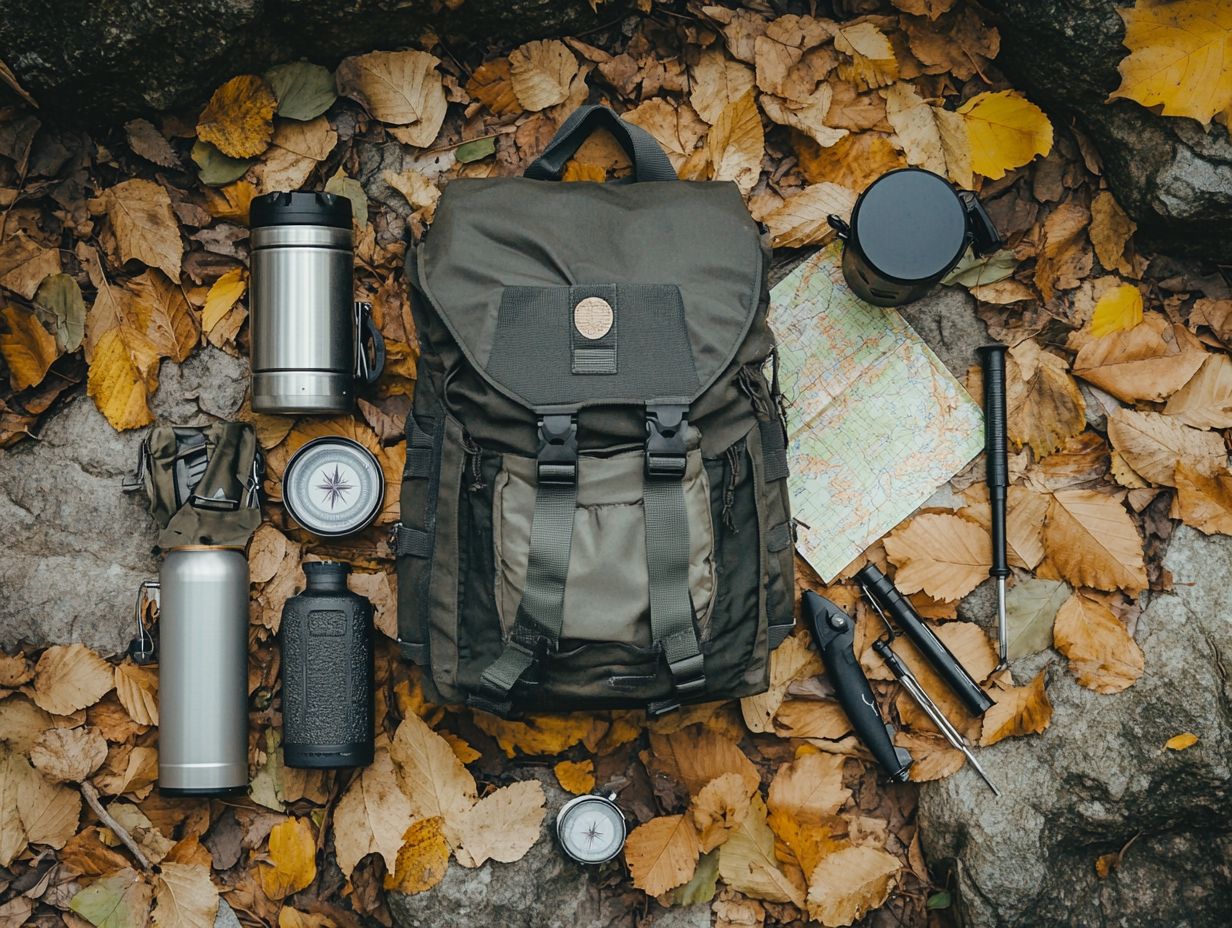
- Invest in proper hiking shoes to prevent foot injuries and provide support on rough terrain.
- Always bring navigation tools like a map and compass to avoid getting lost on unfamiliar trails.
- Pack an emergency kit with essential supplies to treat common hiking injuries and emergencies.
1. Proper Hiking Shoes
Selecting the right hiking shoes is crucial for your hiking success. They provide essential support, grip, and comfort, ensuring your safety whether you’re navigating rocky trails or tackling long-distance backpacking adventures.
A solid pair of hiking shoes can elevate your entire hiking experience, allowing you to immerse yourself in the stunning scenery and the journey itself, rather than being distracted by the discomfort of poor footwear.
When you’re evaluating hiking footwear, pay close attention to traction, waterproofing, and the perfect fit. Good traction is your ally against slips on wet or uneven surfaces, while waterproof hiking footwear keeps your feet dry when the weather decides to throw a curveball.
Sizing is key too tight, and you ll be battling blisters; too loose, and you risk instability.
Brands like REI and Osprey present an impressive array of options catering to various hiking techniques, from lightweight trail runners designed for speed to robust, high-ankle boots built for rugged terrains.
To find the best hiking shoes for the challenges ahead, consider the type of trails you’ll traverse, your unique foot shape, and the climate where your adventures will unfold.
Navigation is essential for your hiking success, ensuring you remain on the right path while immersing yourself in the beauty of the great outdoors. With tools like smartphone navigation apps, hiking maps, and devices such as Garmin’s inReach, you can find your way more easily.
Modern tools like AllTrails and GaiaGPS give you access to detailed trail information, track your progress, and connect with a vibrant community of outdoor enthusiasts eager to share their experiences. Yet, don t underestimate the value of traditional methods; topographic maps and compasses are invaluable, especially in remote areas where cell service might abandon you.
Having various navigation tools on hand makes you ready for anything and helps mitigate the risks of losing your way. Ultimately, the right hiking tools not only inspire a sense of adventure but also greatly enhance your hiking safety on the trail.
3. First Aid Kit
A well-stocked first aid kit is a critical part of your hiking safety arsenal. It helps you deal with possible injuries that might arise during your wilderness adventures, enabling you to respond effectively to a variety of situations.
By ensuring you have key items such as assorted bandages, antiseptics, and essential medications, you can significantly alleviate discomfort and avert complications. For example, adhesive bandages are vital for treating minor cuts and blisters, while antiseptic wipes clean wounds and diminish the risk of infection. Having over-the-counter medications for pain relief and allergies can prove invaluable.
Knowing basic first aid can save the day and gives you the power to handle emergencies while boosting your overall confidence while hiking. By preparing in advance, you can embrace your outdoor experience with peace of mind, knowing you re ready to tackle any unexpected situations that may arise.
4. Sun Protection
Effective sun protection is essential for your outdoor safety during hiking adventures. Equip yourself now to enjoy a safe adventure!
Prolonged exposure to UV rays can lead to skin damage and various health complications. It s crucial to have the right hiking clothes, sunscreen, and protective gear for a safe and enjoyable experience.
When choosing your attire, opt for breathable, UV-protective clothing that covers your skin effectively.
Apply a sunscreen that protects against different types of UV rays with a high SPF. Regularly reapply sunscreen, especially after sweating or swimming, to add that vital extra layer of defense.
Prioritize hydration as your body can quickly become dehydrated in the sun, resulting in fatigue and diminished performance.
Incorporate insect protection to enhance comfort and keep those pesky bugs at bay, making your hiking experience more enjoyable and safe in the great outdoors.
5. Appropriate Clothing
Wearing the right hiking clothes is essential for your comfort and safety. Choosing the right layers helps regulate your body temperature and wick away moisture.
Mastering the art of layering can significantly elevate your hiking experience, especially with temperature fluctuations and unpredictable weather.
Start with a reliable base layer; brands like Patagonia offer high-quality options designed to wick sweat away from your skin, keeping you dry and comfortable.
Next, consider insulation layers that trap heat gear from MSR provides effective warmth without adding bulk, allowing you to move freely.
An outer shell becomes your shield against wind and rain, ensuring that you stay comfortable even in harsh climates.
These seasonal considerations highlight the importance of having the right cold weather gear, making every hike a positive adventure in the great outdoors.
6. Hydration Pack or Water Bottle
Staying hydrated is absolutely critical when you’re out hiking. Choosing between a hydration pack and a water bottle is essential for keeping your energy levels high and your health in check.
A hydration system offers the hands-free convenience you crave, allowing you to sip water effortlessly while on the move, encouraging a steady intake of fluids.
Traditional water bottles often require frequent stops to access and drink, which can interrupt the rhythm of your hiking adventure.
It’s crucial to carry a water filter to ensure any water you collect from streams or lakes is safe to drink. This can provide peace of mind on longer hikes.
To enhance your hydration strategy, pack energy-dense snacks like nuts or energy bars. These will keep your stamina up and provide essential nutrients as you tackle rugged trails.
7. Emergency Shelter
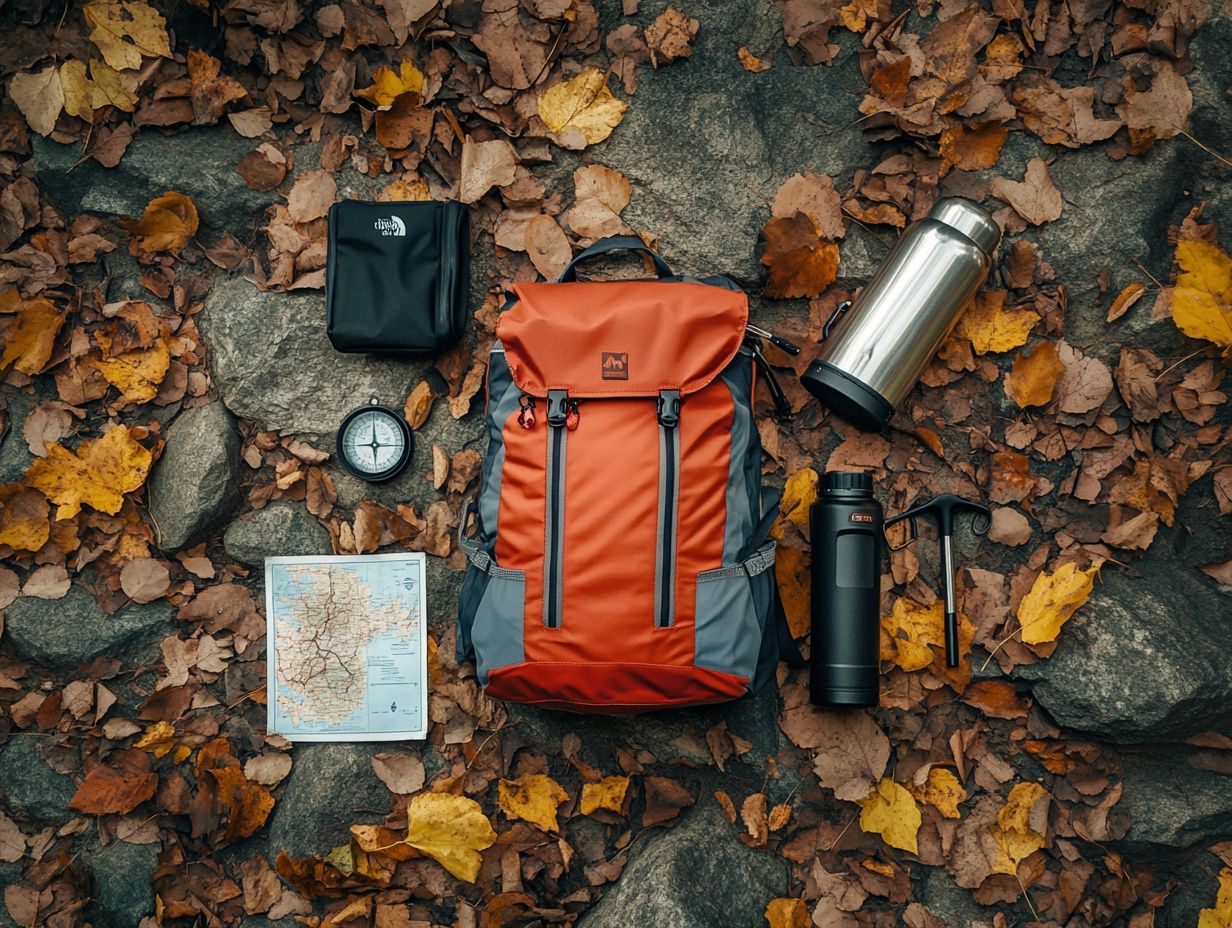
An emergency shelter is your ultimate lifesaver in the wild! It provides protection from sudden weather changes and ensures your safety in unexpected situations while hiking or camping.
These shelters come in various forms, like lightweight tents and bivy sacks, each crafted to offer you a swift refuge from the elements.
A lightweight tent gives you a spacious and comfortable environment, while a bivy sack stands out for its portability, making it perfect for quick setups in emergencies.
Understanding how to set up an emergency shelter properly is crucial. Find the right location and secure it against wind to maximize insulation for warmth.
In adverse weather conditions, having access to such a protective space can be the difference between safety and unnecessary risk. Prepare ahead of time!
8. Headlamp or Flashlight
A reliable headlamp or flashlight is essential for your hiking safety, especially during early morning or late evening trails. It illuminates your path and enhances visibility in the dark, ensuring a safer hiking experience.
Among the various options available, headlamps are the superior choice. Their hands-free operation empowers you to navigate challenging terrains while keeping both hands free for climbing or using your trekking poles.
Headlamps typically offer a wider beam and adjustable brightness settings. Effective battery management is crucial for your trip. Carry extra batteries and a portable charger to ensure that your light source is always ready for use.
9. Multi-Tool or Knife
A reliable multi-tool or knife is an essential companion for your hiking adventures. It serves multiple functions, from making quick repairs to preparing meals, enhancing your outdoor survival skills.
These versatile tools often come equipped with scissors, can openers, and screwdrivers, empowering you to tackle unexpected challenges on the trail. Whether you’re fixing gear or crafting a makeshift shelter, having the right tool at hand makes a significant difference.
Handle these tools carefully to ensure your safety! Always make sure that blades are securely locked before use and store them safely when not in hand to avoid accidental injuries.
10. Whistle
A whistle is an essential tool for hiking safety. It serves as a straightforward way to signal for help in emergencies and should always be part of your Emergency Kit.
Its sharp sound can travel much farther than your voice, making it invaluable in dense forests or mountainous terrains. When you find yourself in a dangerous situation, use the whistle with precision three short blasts signal distress and are universally recognized.
Carrying it on your person ensures immediate access when you need it most. Always stay aware of your surroundings and have a plan for where to go if you need to call for help.
11. Insect Repellent
Effective insect repellent is your ally in hiking safety, offering vital protection against pesky bites from mosquitoes and ticks that can carry diseases. With the right repellent, you can enjoy the beauty of nature without the distraction of insects.
You ll find various insect repellents on the market, like sprays, lotions, and natural options infused with essential oils. Sprays typically offer broader coverage, while lotions provide precise application.
Using repellents along with appropriate clothing is essential for protection. Opt for lightweight, long-sleeved garments and consider fabrics treated with insect repellent for extra safety and comfort.
Adopting a complete approach that blends effective insect repellent with suitable attire is key to maximizing your outdoor enjoyment.
12. Map and Compass
Using a map and compass is an essential skill for trail navigation, especially if you re keen on exploring off the beaten path. These tools offer reliable guidance in situations where technology might let you down.
When you master the art of reading maps and using a compass, you empower yourself to traverse unfamiliar terrains with confidence. This not only enhances your hiking experience but also minimizes the chances of getting lost along the way.
By understanding the intricacies of maps that show land features and elevations like elevation changes and landmarks you can anticipate challenges and plan your routes effectively. Knowing how to set bearings ensures you remain oriented, especially in dense forests or vast wilderness areas.
This knowledge boosts your safety. It also enhances your preparedness, providing you with peace of mind as you immerse yourself in nature s breathtaking beauty.
13. Emergency Communication Device
An emergency communication device, like the Garmin inReach, is a critical companion for hikers. It offers the unparalleled peace of mind that comes with the ability to send messages or alerts in case of emergencies. This significantly enhances your overall hiking safety.
These devices allow for seamless two-way messaging and provide GPS tracking, a feature that shows where you are on a map. This can be crucial if anything goes awry during a hike, as rescuers can pinpoint your exact location without delay.
When choosing an emergency communication device, prioritize features such as battery life, signal reliability, and weather resistance. By ensuring you have connectivity with a dependable device, you can explore the great outdoors with confidence, knowing you have a reliable means to summon help if necessary while fully enjoying nature’s beauty. For those adventurous enough to venture into colder climates, having the essential gear for winter hiking is also crucial.
14. Snacks and Food
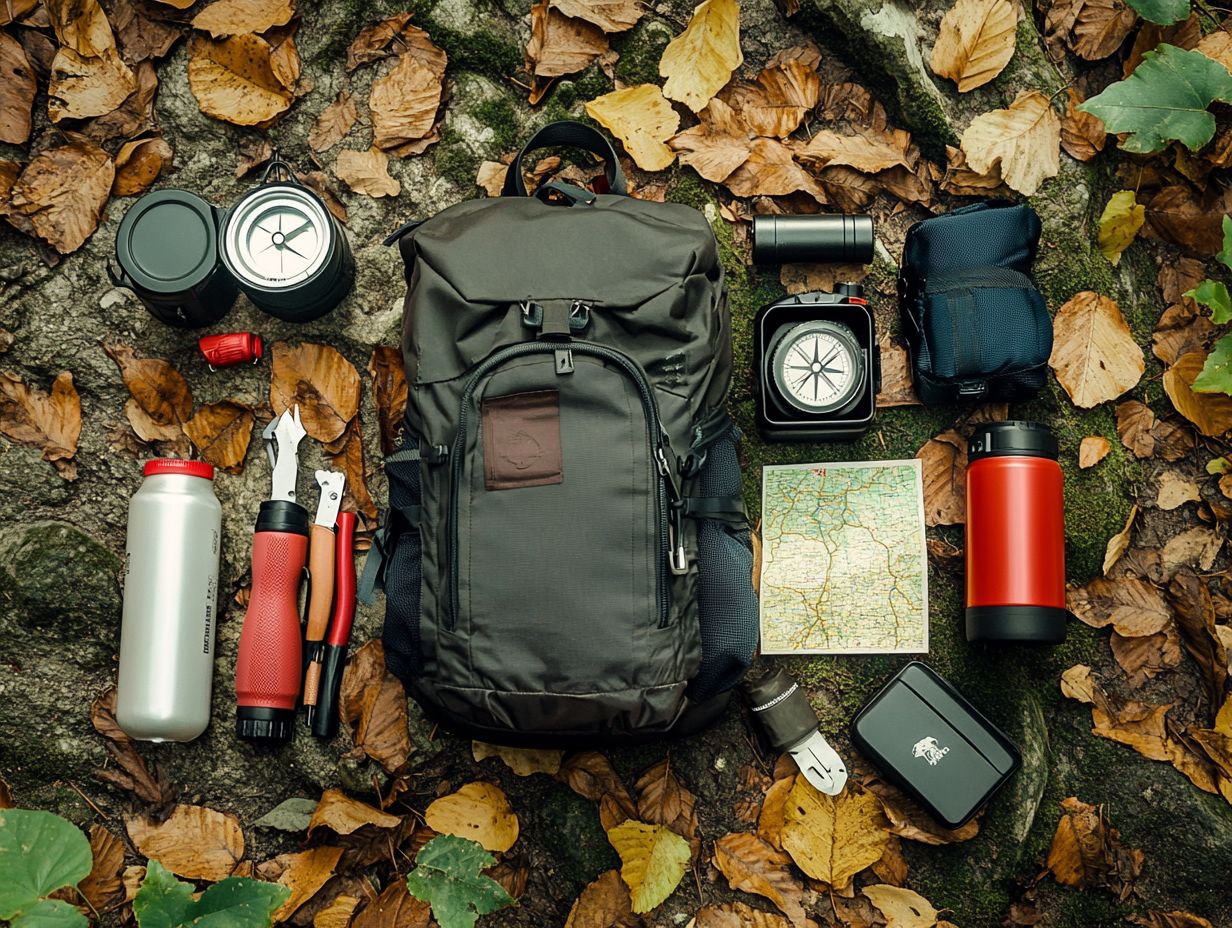
Hiking snacks are a crucial component of your hiking experience. They provide the essential energy and nutrients needed to sustain you on your adventures. It’s important to select them with care, ensuring they are lightweight, nutritious, and easy to pack.
Energy bars rank among the finest choices, offering a convenient combination of carbohydrates and protein for lasting energy. Nuts, such as almonds or walnuts, deliver healthy fats and a satisfying crunch. Dried fruits like apricots and raisins offer quick sugars for an instant boost.
Imagine enjoying the great outdoors with delicious snacks fueling your adventure! Pairing these snacks with a hydration system, such as a water bladder or reusable bottle, not only keeps you refreshed but also elevates your performance. Staying properly hydrated along with your thoughtfully selected snacks can significantly enhance your energy levels, transforming your hiking experience into something truly enjoyable and invigorating. For those planning to extend their outdoor adventures, it’s also essential to know how to camp while hiking with the right gear essentials.
15. Personal Identification and Emergency Contact Information
Carrying personal identification and emergency contact information while hiking is a wise safety measure. It ensures you can be easily identified and that your loved ones can be notified in case of an emergency during your outdoor adventures.
To securely store this essential information, consider using bags or pouches designed to withstand the elements. This keeps your details safe from moisture and damage. Additionally, don’t forget to include essential first aid gear for camping by placing a copy of your hiking plans complete with your intended route and estimated return time in the same bag adds an extra layer of safety. For more tips, check out essential first aid gear for camping.
Equally important is informing a friend or family member about your plans before you set off. This way, someone knows where you’re supposed to be, making it easier for help to reach you in unforeseen circumstances. Additionally, having the right essential hiking gear for beginners can significantly enhance your safety as you savor the beauty of the great outdoors.
What Are the Most Common Injuries While Hiking and How Can They Be Prevented?
Understanding the most common hiking injuries, such as sprains, blisters, and heat-related illnesses, along with effective prevention strategies, is essential for ensuring a safe and enjoyable experience. This is especially true when you re tackling challenging trails.
You might not realize how much your gear influences your overall safety and comfort. For example, wearing ill-fitting footwear can lead to painful blisters, turning an exhilarating trek into a real struggle. A friend of yours learned this lesson the hard way one sweltering summer day. They finished the hike with bandaged feet and a newfound appreciation for breaking in shoes before a long journey.
Heat-related illnesses can easily catch anyone off guard if the right clothing isn’t selected. Opt for lightweight, quick-drying fabrics to make a world of difference. Investing in quality gear not only enhances your performance but also plays a crucial role in preventing injuries. To ensure your equipment remains safe during your outings, check out how to protect your gear while hiking. Thoughtful preparation can lead to unforgettable adventures in the great outdoors.
What Are Some Additional Safety Tips to Keep in Mind While Hiking?
Along with your essential gear, incorporating hiking safety tips like staying updated on weather conditions, informing someone about your plans, and understanding the trail s challenges can significantly enhance your safety and overall enjoyment during outdoor adventures.
To stay safe, check trail conditions before you leave; these can change rapidly due to weather or maintenance work. Utilizing a buddy system ensures there’s always someone by your side to assist in emergencies. Respecting wildlife fosters harmony in nature and protects both hikers and animals. Additionally, make sure you have the right equipment by exploring hiking gear: must-have items for all seasons.
Always carry a fully charged phone, a map, and a first aid kit. Familiarize yourself with basic navigation skills. Additionally, consider bringing essential gear for a successful backpacking trip. By prioritizing thorough preparation, you not only mitigate risks but also create a more enjoyable experience in the great outdoors.
What Are the Best Practices for Packing and Distributing Weight in a Hiking Backpack?
Mastering the art of packing and distributing weight in your hiking backpack is essential for maximizing comfort and efficiency on the trail. Proper weight distribution alleviates discomfort and enhances your overall hiking experience.
Understanding how to organize your gear effectively can transform your journey, especially when navigating uneven terrain or tackling long distances. By positioning heavier items, such as your sleeping bag or cooking gear, close to your back, you maintain balance and stability, thereby reducing strain on your shoulders and hips. Additionally, having the essential first aid kit for hikers easily accessible can provide peace of mind during your adventures.
Don’t underestimate the importance of utilizing every pocket and compartment at your disposal. Keep smaller items easily accessible while ensuring your load feels secure and evenly distributed. Choose a lightweight backpack that aligns with your specific needs to complement these techniques beautifully, and consider adding must-have navigation tools for hikers to immerse yourself in nature without being bogged down.
How Can One Prepare for Potential Weather Changes While Hiking?
Preparing for potential weather changes while hiking is crucial for your safety and comfort. Unpredictable weather can dramatically transform your outdoor experience. It’s essential to have the right clothing and gear on hand for any scenario and a reliable hydration system like water bottles or hydration packs.
Understanding the local climate and regularly checking forecasts gives you the power to plan your adventures effectively, enabling well-considered choices. By monitoring temperature fluctuations, wind patterns, and the possibility of precipitation, you can equip yourself more efficiently.
Invest in versatile cold weather gear for better protection. Learning how to layer your clothes will significantly enhance your keeping warm. This strategy not only creates a shield against brisk winds but also allows for easy adjustments as temperatures shift, ultimately ensuring your outdoor journey is both enjoyable and safe.
What Are the Benefits of Using Trekking Poles While Hiking?
Using trekking poles while hiking presents a wealth of benefits that elevate your outdoor experience. Imagine hiking with confidence, feeling stable and reducing strain on your joints! You’ll enjoy improved stability, reduced strain on your joints, and enhanced endurance, making them an essential addition to your gear for everything from leisurely strolls to challenging trails.
These versatile tools help distribute your body weight, alleviating pressure on your knees and hips especially beneficial during steep descents, where maintaining control is paramount. By keeping a proper grip and employing a diagonal movement pattern, you can maximize the effectiveness of the poles, thereby enhancing your overall balance and rhythm. Adjust the length of the poles according to the terrain: shorter for uphill climbs and longer for downhill descents.
With regular practice in incorporating these poles into your stride, you’ll likely notice a significant reduction in fatigue, allowing you to embark on longer and more enjoyable hikes.
Frequently Asked Questions
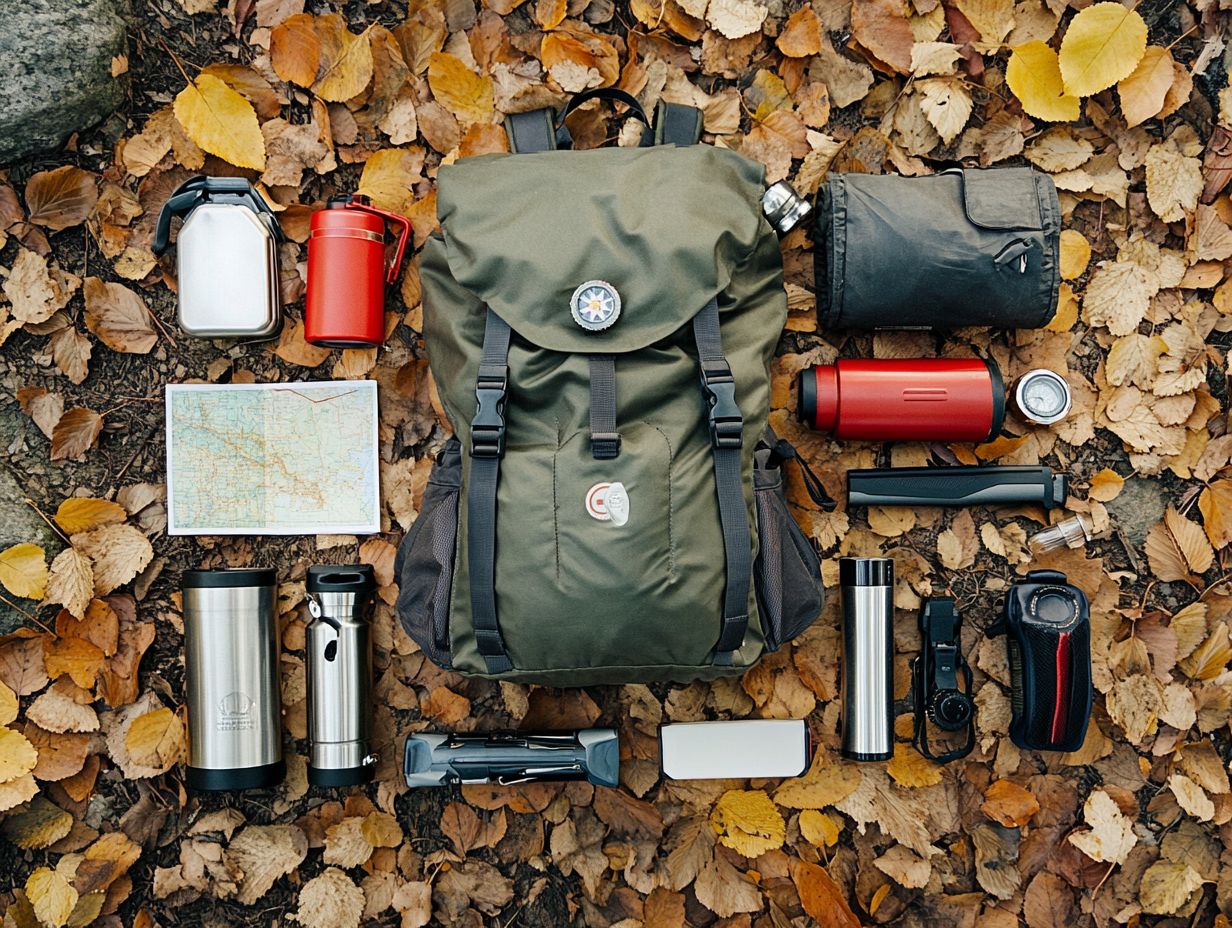
What are the essential accessories for a safe hiking trip?
The essential accessories for a safe hiking trip include a map and compass, first aid kit, water and hydration supplies, proper hiking shoes, weather-appropriate clothing, hiking gear, and a headlamp or flashlight.
Why is it important to have a map and compass for a hiking trip?
A map and compass are essential for a safe hiking trip because they help you navigate and stay on the right trail. They can also assist you in finding your way back if you get lost.
What should be included in a first aid kit for a hiking trip?
A first aid kit for a hiking trip should include bandages, antiseptic ointment, pain relievers, blister pads, and any necessary medication. It’s also important to have a first aid manual and know how to use the items in the kit. Don’t forget to pack insect protection.
Don’t wait! Gear up and prepare for your next adventure today!
Why is proper footwear necessary for a hiking trip?
Proper footwear, like hiking shoes or boots, is essential for a thrilling and safe hiking experience! It provides support and traction on various terrains, helping you avoid injuries and blisters.
What type of clothing should I pack for a safe hiking trip?
The clothes you bring should be suitable for the weather and made from materials that dry quickly and breathe well. Dress in layers so you can adjust to changing temperatures easily.
Why is it important to have a headlamp or flashlight for a hiking trip?
A headlamp or flashlight is crucial, especially when hiking in low light or darkness. It can help you navigate and signal for help in emergencies. Don’t forget a portable charger for your devices!

